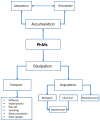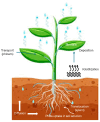How Pharmaceutical Residues Occur, Behave, and Affect the Soil Environment
- PMID: 39449417
- PMCID: PMC11503385
- DOI: 10.3390/jox14040076
How Pharmaceutical Residues Occur, Behave, and Affect the Soil Environment
Abstract
Many pharmaceuticals (PhMs), compounds for the treatment or prevention of diseases in humans and animals, have been identified as pollutants of emerging concern (PECs) due to their wide environmental distribution and potential adverse impact on nontarget organisms and populations. They are often found at significant levels in soils due to the continuous release of effluent and sludge from wastewater treatment plants (WWTPs), the release of which occurs much faster than the removal of PhMs. Although they are generally present at low environmental concentrations, conventional wastewater treatment cannot successfully remove PhMs from influent streams or biosolids. In addition, the soil application of animal manure can result in the pollution of soil, surface water, and groundwater with PhMs through surface runoff and leaching. In arid and semiarid regions, irrigation with reclaimed wastewater and the soil application of biosolids are usual agricultural practices, resulting in the distribution of a wide number of PhMs in agricultural soils. The ability to accurately study the fate of PhMs in soils is critical for careful risk evaluation associated with wastewater reuse or biosolid return to the environment. The behavior and fate of PhMs in soils are determined by a number of processes, including adsorption/desorption (accumulation) to soil colloids, biotic (biodegradation) and abiotic (chemical and photochemical degradation) degradation, and transfer (movement) through the soil profile. The sorption/desorption of PhMs in soils is the main determinant of the amount of organic chemicals taken up by plant roots. The magnitude of this process depends on several factors, such as crop type, the physicochemical properties of the compound, environmental properties, and soil-plant characteristics. PhMs are assumed to be readily bioavailable in soil solutions for uptake by plants, and such solutions act as carriers to transport PhMs into plants. Determining microbial responses under exposure conditions can assist in elucidating the impact of PhMs on soil microbial activity and community size. For all of the above reasons, soil remediation is critical when soil pollutants threaten the environment.
Keywords: emerging pollutants; pharmaceuticals; plant uptake; soil behavior; soil remediation.
Conflict of interest statement
The authors declare no conflict of interest.
Figures









Similar articles
-
The potential implications of reclaimed wastewater reuse for irrigation on the agricultural environment: The knowns and unknowns of the fate of antibiotics and antibiotic resistant bacteria and resistance genes - A review.Water Res. 2017 Oct 15;123:448-467. doi: 10.1016/j.watres.2017.07.004. Epub 2017 Jul 3. Water Res. 2017. PMID: 28689129 Review.
-
Sorption and degradation of contaminants of emerging concern in soils under aerobic and anaerobic conditions.Sci Total Environ. 2019 May 20;666:662-671. doi: 10.1016/j.scitotenv.2019.02.279. Epub 2019 Feb 20. Sci Total Environ. 2019. PMID: 30812000
-
Predicting concentrations of trace organic compounds in municipal wastewater treatment plant sludge and biosolids using the PhATE™ model.Integr Environ Assess Manag. 2012 Jul;8(3):530-42. doi: 10.1002/ieam.1274. Epub 2012 Feb 7. Integr Environ Assess Manag. 2012. PMID: 22162313
-
Ranking of crop plants according to their potential to uptake and accumulate contaminants of emerging concern.Environ Res. 2019 Mar;170:422-432. doi: 10.1016/j.envres.2018.12.048. Epub 2018 Dec 21. Environ Res. 2019. PMID: 30623890 Review.
-
Translating wastewater reuse for irrigation from OECD Guidelines: Tramadol sorption and desorption in soil-water matrices.Chemosphere. 2022 Oct;305:135031. doi: 10.1016/j.chemosphere.2022.135031. Epub 2022 May 20. Chemosphere. 2022. PMID: 35605731
Cited by
-
Pharmaceuticals and radiopharmaceuticals in wastewater treatment plants: insights from an Arabian Peninsula nation.Environ Sci Pollut Res Int. 2025 Mar;32(15):9844-9871. doi: 10.1007/s11356-025-36287-6. Epub 2025 Mar 29. Environ Sci Pollut Res Int. 2025. PMID: 40156705 Free PMC article.
-
Pollution by antimicrobials and antibiotic resistance genes in East Africa: Occurrence, sources, and potential environmental implications.Toxicol Rep. 2025 Feb 22;14:101969. doi: 10.1016/j.toxrep.2025.101969. eCollection 2025 Jun. Toxicol Rep. 2025. PMID: 40104048 Free PMC article. Review.
References
-
- Sörengård M., Campos-Pereira H., Ullberg M., Lai F.Y., Golovko O., Ahrens L. Mass loads, source apportionment, and risk estimation of organic micropollutants from hospital and municipal wastewater in recipient catchments. Chemosphere. 2019;234:931–941. doi: 10.1016/j.chemosphere.2019.06.041. - DOI - PubMed
-
- Tijani J.O., Fatoba O.O., Babajide O.O., Petrik L.F. Pharmaceuticals, endocrine disruptors, personal care products, nanomaterials and perfluorinated pollutants: A review. Environ. Chem. Lett. 2016;14:27–49. doi: 10.1007/s10311-015-0537-z. - DOI
-
- Pérez-Carrera E., Hansen M., León V.M., Björklund E., Krogh K.A., Halling-Sørensen B., González-Mazo E. Multiresidue method for the determination of 32 human and veterinary pharmaceuticals in soil and sediment by pressurized-liquid extraction and LC-MS/MS. Anal. Bioanal. Chem. 2010;398:1173–1184. doi: 10.1007/s00216-010-3862-x. - DOI - PubMed
Publication types
LinkOut - more resources
Full Text Sources

